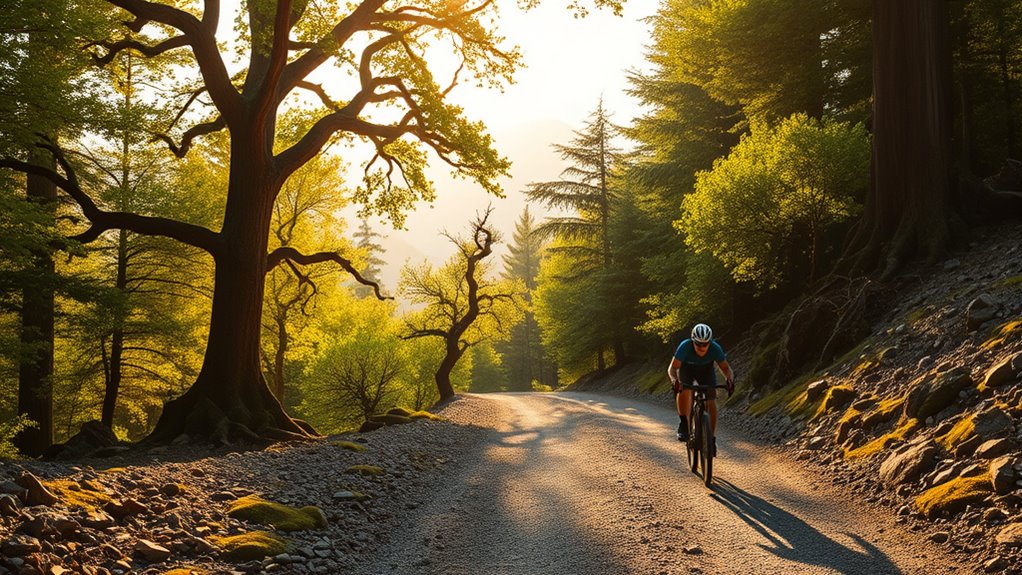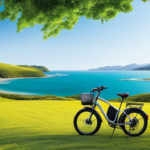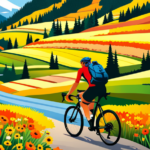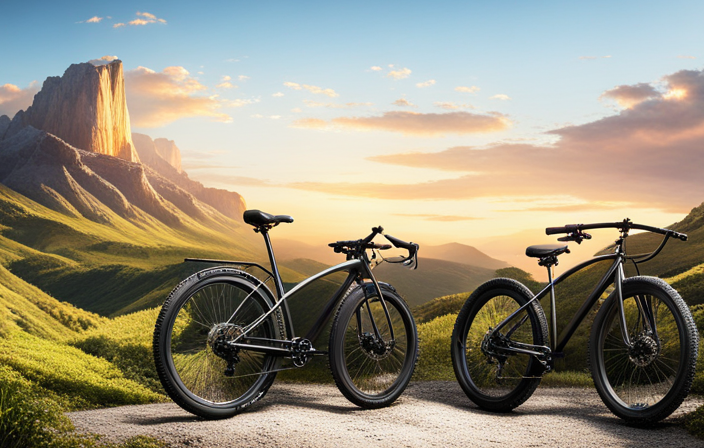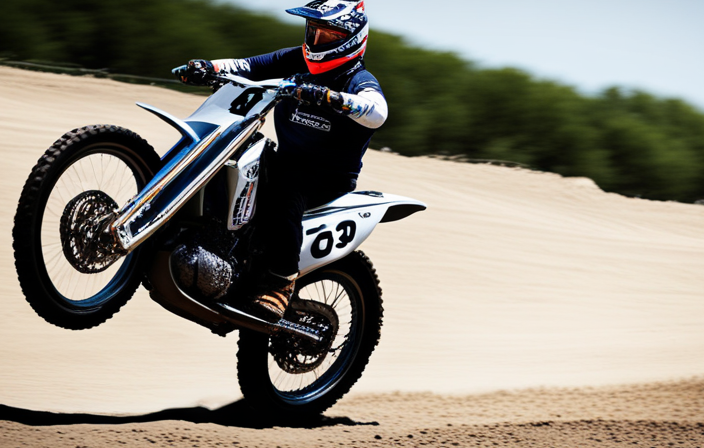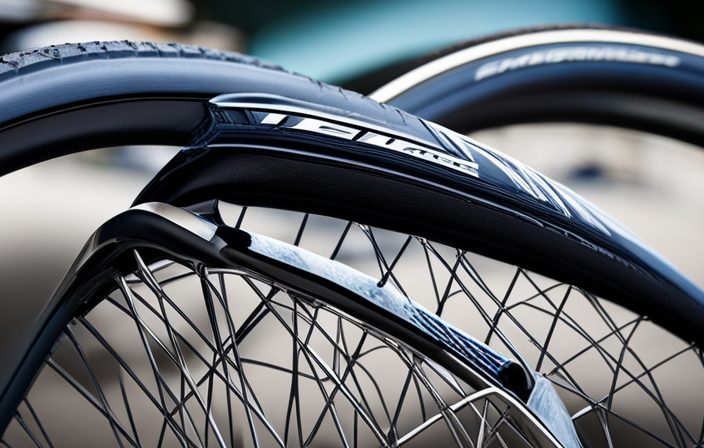Gravel biking takes you off the beaten path to explore scenic, less-traveled roads that connect you to nature’s hidden gems. You’ll discover diverse landscapes like forests, coastal trails, and rural villages, all perfect for adventure. With the right bike and gear, you can navigate tricky terrains, build your skills, and join a passionate community. Keep going to learn how to get started and make the most of your gravel riding journeys.
Key Takeaways
- Gravel biking offers access to scenic, less-traveled routes through diverse landscapes like forests, rural villages, and coastal areas.
- Proper bike selection with wider tires and stable geometry enhances control on rough, unpaved roads.
- Navigation tools and local resources help discover hidden gems and remote routes away from busy traffic.
- Preparing gear, safety equipment, and terrain awareness ensures safe exploration on challenging and varied terrains.
- Building skills and endurance through gradual training unlocks more adventurous, less-traveled gravel routes for exploration.
The Allure of Gravel Biking and Its Growing Popularity

Gravel biking has quickly become one of the most exciting and fastest-growing sectors in cycling, drawing in enthusiasts with its unique blend of adventure and versatility. As a gravel biker, you’re drawn to exploration, discovering remote areas and unpaved roads that open up new horizons. This sport appeals to a broad demographic because it combines the thrill of mountain biking with the speed and efficiency of road cycling. The expanding network of gravel roads across the U.S., now over a million miles, offers endless opportunities for adventure and long-distance rides. The rise of dedicated gravel bikes and accessories makes it easier to navigate rough terrains confidently. Community events, organized rides, and media coverage continue to fuel the sport’s popularity, inspiring more riders to embrace the cycling world’s newest frontier.
Discovering Scenic Routes and Hidden Gems
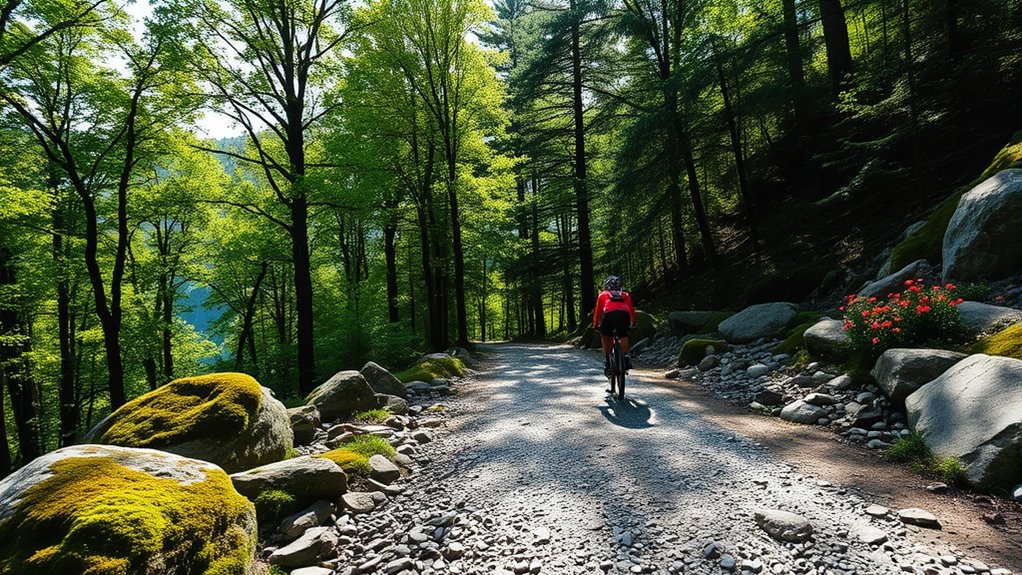
Have you ever wondered where your next scenic adventure could take you? Gravel biking opens the door to exploring scenic routes filled with diverse landscapes—rolling hills, lush forests, and coastal trails that showcase natural beauty at every turn. Along these gravel roads, you’ll discover hidden gems like historic landmarks, secluded waterfalls, and charming rural villages, offering rich cultural and scenic experiences. Many routes pass through areas with minimal traffic, giving you peaceful rides and unobstructed views of untouched nature. Popular destinations like Tuscany, Algarve, and Catalonia boast vineyards, medieval architecture, and rugged mountain vistas that leave lasting impressions. Online resources like GravelMap.com make it easy to find lesser-known routes that highlight these stunning natural attractions and secret spots waiting to be explored. Exploring these routes can also enhance your outdoor skills and deepen your connection with the environment, fostering a greater appreciation for holistic wellness and sustainable travel. Additionally, engaging with local communities along these routes can enrich your travel experience and promote sustainable tourism. Recognizing the importance of spiritual connection can also add a meaningful dimension to your outdoor adventures.
Choosing the Perfect Gravel Bike for Your Adventures
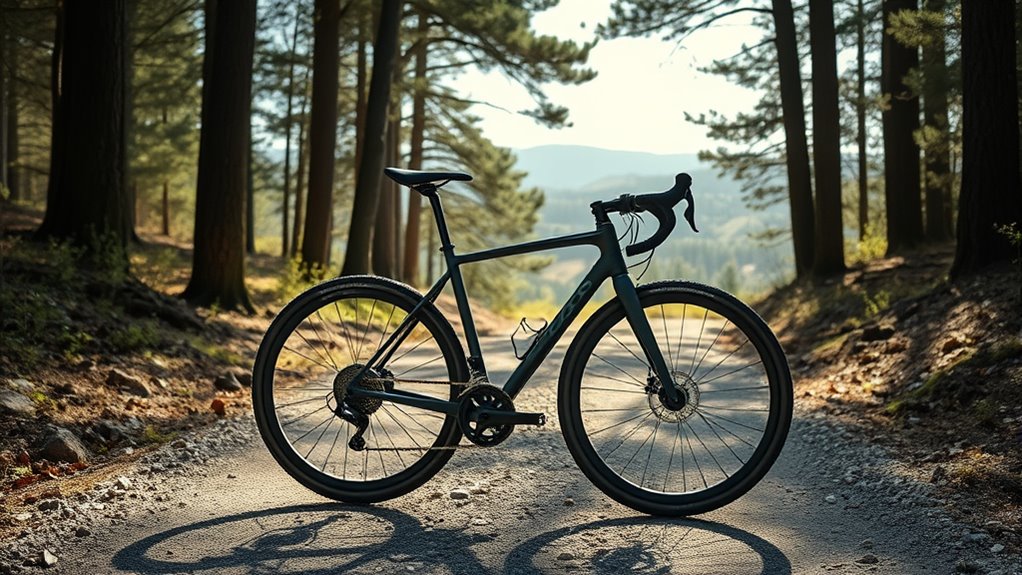
To choose the right gravel bike, you need to take into account your terrain and riding style, which influence your options for frame, tires, and components. Think about the bike’s compatibility with racks, bags, and other accessories to match your adventure goals. Balancing features like tire width, wheel choices, and gear setups ensures you get the best performance on your gravel journeys. Considering innovative modular bike design options can also enhance customization and adaptability for your specific needs.
Bike Frame Options
Choosing the right bike frame is essential for a smooth and confident gravel riding experience. Your gravel bike’s frame determines stability, comfort, and handling on rough terrain. Look for models with longer, more stable geometry and an extended wheelbase to improve control over uneven surfaces. Wide tire clearance—up to 45mm or more—allows you to run knobbier tires for better off-road traction. Material options include lightweight carbon fiber for performance, durable aluminum for affordability, and steel for comfort and easy repairs. Many frames feature multiple mounts for racks, cages, and bags, supporting bikepacking adventures. Internal cable routing and reinforced frame points boost durability and protect components during rugged rides. Choosing the correct frame ensures your gravel adventures are enjoyable and confidently handled.
Tire and Wheel Choices
Selecting the right tires and wheels is essential for enhancing your gravel riding experience. Your gravel tires typically range from 35mm to 45mm wide; wider tires offer better traction and comfort on rough terrain. Tubeless tires are highly recommended because they reduce flats and allow lower pressures for improved grip and a smoother ride. Pay attention to tire tread patterns: slick or lightly treaded tires excel on hard-packed surfaces, while knobby or aggressive treads provide maximum grip on loose gravel and rocky trails. Wheel choices usually involve 700c or 650b diameters. For rugged routes, 650b wheels with wider tires deliver increased stability and comfort. Match your wheel choices and tire tread to your terrain and riding style for an ideal gravel adventure. Understanding angel numbers can also inspire your journey and personal growth along the way.
Gear and Component Compatibility
Ensuring your gravel bike has compatible gears and components is essential to optimizing performance across varied terrains. Your drivetrain must match your riding style, whether you prefer a 1x or 2x setup, with wide gear ranges like 11-42T or 10-50T to tackle steep climbs and fast descents. Tire clearance is also vital—look for bikes that can accommodate 38c to 45c tires for better traction and stability. Proper component compatibility guarantees smooth shifting and reliable braking, especially with disc brakes (mechanical or hydraulic). Additionally, considering component durability can inspire innovative modifications to improve your bike’s performance and customization, ensuring your gravel bike is tailored to your adventures. When selecting upgrades, integrating Kia Tuning principles such as suspension modifications or performance enhancements can further optimize your bike for diverse conditions.
Planning Your First Gravel Ride

Planning your first gravel ride begins with thorough research to find suitable routes that match your skill level. Use online resources like GravelMap.com or connect with local cycling clubs to discover gravel routes that fit your experience. Start with beginner-friendly trails that have manageable terrain and gradually increase difficulty as you gain confidence. Make sure your gear is ready—choose a gravel-specific bike with appropriate tire clearance (38-45mm) and comfortable geometry for long rides. Check trail status and weather conditions beforehand to avoid surprises. It’s also smart to inform someone about your plans and expected return time for safety. Packing essential safety gear, like a helmet, repair kit, and navigation tools, ensures you’re prepared for any situation along the way. Incorporating space and organization into your gear setup can help keep your belongings accessible and prevent clutter during your ride. Additionally, understanding essential safety tips can enhance your confidence and preparedness on unfamiliar terrain. Paying attention to bike maintenance beforehand can prevent mechanical issues during your ride. Remember to know your limits and ride within your comfort zone to enjoy a safe and enjoyable gravel biking experience.
Essential Gear and Safety Tips for Gravel Biking
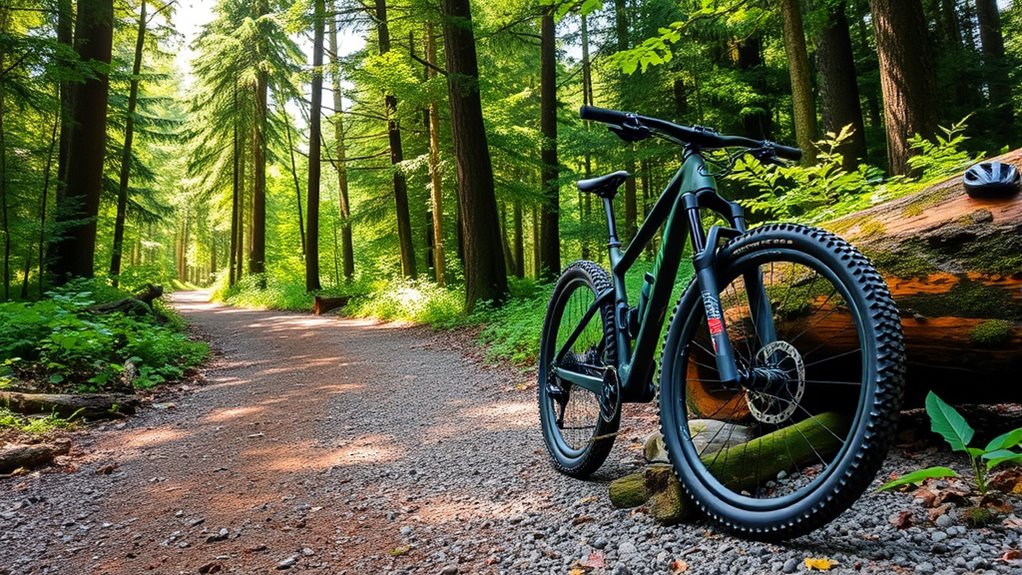
Getting your gear right is key to a safe and enjoyable gravel biking experience. Make sure you’re equipped with the right gravel gear, including a well-fitting helmet, gloves, padded shorts, and high-visibility clothing to stay safe on uneven terrain. Use a gravel-specific bike with wider tires (at least 40mm) and a durable frame to handle rough surfaces and minimize flats. Carry a repair kit with multi-tools, spare tubes, patch kits, and a mini pump so you can quickly fix mechanical issues. Bring navigation tools like GPS devices or reliable smartphone apps to stay on course, especially in remote areas. Remember, safety tips also include staying hydrated and energized with hydration packs and snacks. Staying prepared guarantees you enjoy every mile of your gravel adventure. Additionally, choosing a lightweight and durable material for your gear can make a significant difference in comfort and performance during long rides. Being aware of beach environment factors such as wave and wind conditions can help you better plan your route and stay safe, especially if your ride takes you near coastal areas. Properly protecting your gear from elements, such as mud and water, can also extend its lifespan and ensure consistent performance. Incorporating skin care routines like eye patches into your post-ride recovery can help reduce fatigue and promote quicker healing, ensuring you’re ready for your next adventure. Recognizing the importance of regular maintenance and safety checks on your bike can prevent accidents and mechanical failures during your rides.
Navigating Different Terrain and Trail Conditions

Mastering different terrain and trail conditions is a core skill in gravel biking, as routes often shift from smooth double tracks to rugged, rocky paths without warning. You’ll encounter diverse surfaces like dirt roads, jeep trails, and singletrack, each demanding quick adjustments. Trail conditions can change rapidly, so stay alert for obstacles such as hidden boulders, washed-out bridges, or creek crossings. These features require careful handling and terrain awareness to stay safe. Using GPS devices like Wahoo cycling computers helps you navigate unfamiliar or complex routes, ensuring you stay on course. As you encounter emerging dirt roads or challenging obstacles, trust your skills and judgment to adapt smoothly. Flexibility and attention to trail conditions are key to enjoying and conquering every part of your gravel biking adventure. Additionally, understanding tire pressure adjustments is crucial for maintaining traction and comfort across different surfaces.
Building Endurance and Skill for Off-Road Exploration

Building endurance and skill for off-road exploration requires a deliberate and consistent approach. To improve your gravel rides, gradually increase ride distances by 10-20% weekly, ensuring steady stamina growth. Incorporate interval training, alternating high-intensity efforts with recovery, to boost cardiovascular fitness and technical skills on rough terrain. Practice key technical skills like steering around obstacles, cornering on loose surfaces, and handling diverse terrain to build confidence and control. Additionally, strength training—focusing on squats, core workouts, and balance drills—enhances stability and power transfer during long off-road rides. To succeed, remember:
- Regularly ride on various gravel surfaces to adapt to changing conditions
- Focus on incremental progress to prevent burnout or injury
- Combine endurance with technical skill drills for thorough off-road readiness
Connecting With the Gravel Community and Future Events
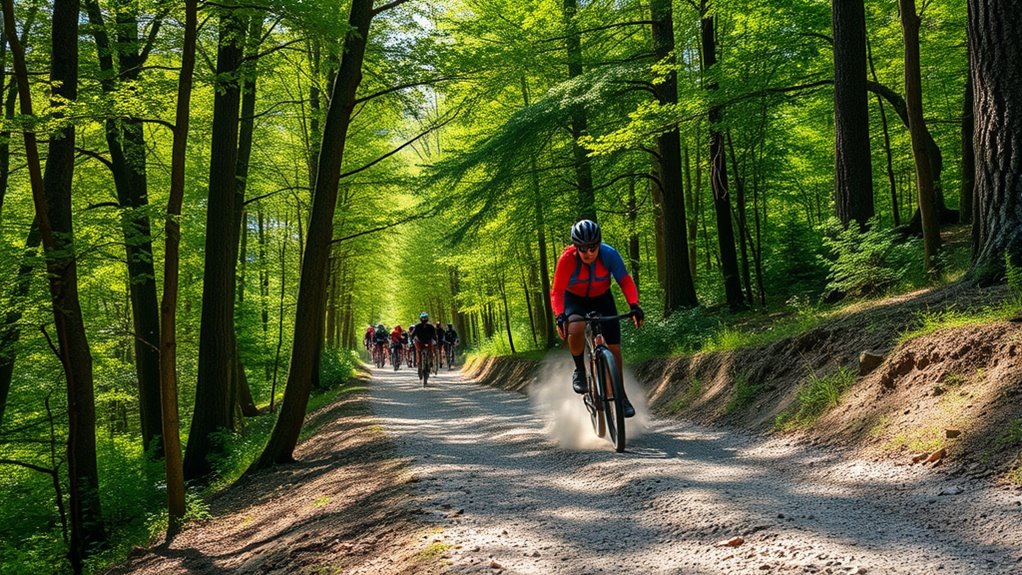
Connecting with the gravel community is a great way to share experiences and find new riding partners. Events like Gravel Camp and Rebecca Rusch’s races bring riders together and foster lasting bonds. As the gravel scene continues to grow, more rides and gatherings will offer opportunities to get involved and stay inspired.
Building Community Bonds
The gravel community thrives on shared experiences that foster camaraderie and a sense of belonging. Participating in organized rides, events, and social gatherings creates strong bonds among riders. These activities offer opportunities to connect with others who share your passion, whether you’re a casual rider or a competitive racer. Online platforms and social media groups further strengthen the community by allowing you to exchange route tips, gear advice, and event updates.
- Building friendships through common interests
- Supporting each other’s growth and achievements
- Celebrating milestones together
Upcoming Gravel Events
Wondering what upcoming gravel events you should mark on your calendar? There are plenty of gravel rides and races scheduled throughout the year that keep the community engaged and enthusiastic for exploration. Events like Rebecca’s Private Idaho and the Virginia Gravel Camp series are perfect opportunities to connect with fellow riders and experience diverse terrains. Local cycling groups organize regional gravel rides that foster camaraderie and skill development. These upcoming events often cater to all skill levels, from beginners to seasoned racers, encouraging wider participation. The gravel community actively promotes future events through online calendars, social media, and cycling clubs, ensuring you stay informed and motivated. Mark your calendar, join the fun, and become part of the ever-growing gravel community.
Frequently Asked Questions
What Are the Best Maintenance Practices for Gravel Bikes?
You need to keep your gravel bike in top shape by regularly cleaning and lubricating the chain, checking tire pressure, and inspecting for wear. Make sure to tighten bolts and replace brake pads when they’re worn down. After each ride, especially on muddy or dusty trails, clean your bike thoroughly. Routine maintenance like these keeps your bike smooth, prevents breakdowns, and guarantees you get the most out of every adventure.
How Do I Choose the Right Tire Pressure?
Perfectly pinpointing your tire pressure is pivotal for a smooth, safe ride. Start by considering terrain—softer surfaces call for lower pressure to increase grip, while harder roads need higher pressure for speed. You’ll want to experiment with small adjustments, feeling how each change impacts traction and comfort. Check your tires regularly, and remember, maintaining ideal pressure maximizes mileage, minimizes mishaps, and makes your ride more reliable and enjoyable.
What Are Common Injuries Associated With Gravel Biking?
When you ride gravel bikes, common injuries include scrapes, cuts, and bruises from falls on uneven terrain. Overuse injuries like knee pain, saddle sores, and wrist strain also happen from prolonged riding. To stay safe, wear protective gear, maintain proper technique, and listen to your body. Ensuring your bike fits well and taking breaks can help prevent many of these issues, keeping your rides enjoyable and injury-free.
Can I Ride Gravel Bikes on Paved Roads?
Did you know that over 60% of gravel bike riders also enjoy paved roads? You can absolutely ride gravel bikes on paved surfaces—they’re versatile and built for mixed terrain. Just keep in mind, they may be a bit heavier than road bikes, so you might feel a slight difference in speed or agility. Overall, gravel bikes are great for exploring both smooth pavements and rugged trails, offering you flexibility and adventure.
How Do I Find Local Gravel Biking Groups or Events?
You can find local gravel biking groups or events by checking online platforms like Meetup, Facebook, or local cycling forums. Visit bike shops or community centers for flyers or recommendations. Join local cycling clubs or social media groups dedicated to gravel riding. Attending mountain biking or cycling events can also connect you with fellow enthusiasts. Don’t hesitate to ask around—many riders love sharing their favorite routes and upcoming events.
Conclusion
Gravel biking takes you off the beaten path, revealing breathtaking scenery and hidden gems. It’s about embracing adventure and uncertainty, yet staying prepared and safe. The thrill of exploring rugged trails contrasts with the calm of scenic routes, reminding you that every journey offers both challenge and serenity. So, gear up, stay curious, and enjoy the ride — the road less traveled is where you’ll find the most unforgettable moments.
